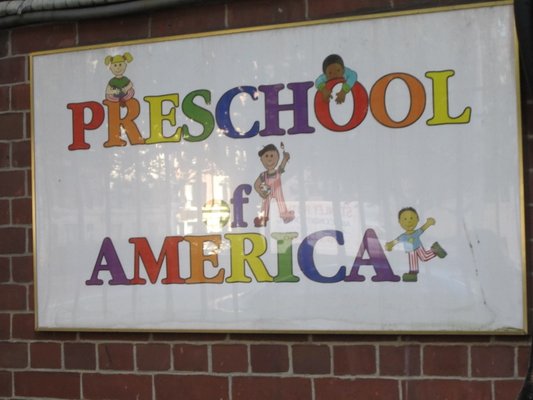Please Go to Preschool So I Can Die Happy
 Monday, September 16, 2013 at 12:25PM
Monday, September 16, 2013 at 12:25PM We’ve gone back to school at the Back Road Café, at least in the US branch. Last week’s lesson: what is taught in high school US history classes? This week: why are Americans so ambivalent about preschool?
“Government should fund universal preschool!” I must admit I was surprised to hear President Barack Obama and New York Mayor-Elect (probably) Bill De Blasio argue so passionately this year in favor of preschool as part of their platforms and budgets.
 I know this sounds Neanderthal to most European countries, with their family friendly policies and laws supporting parental leave, childcare and early childhood education. But in the US, there is no government-supported maternity leave or childcare, and then you have to be five years old before you get free and mandatory public education. Your education starts in Kindergarten.
I know this sounds Neanderthal to most European countries, with their family friendly policies and laws supporting parental leave, childcare and early childhood education. But in the US, there is no government-supported maternity leave or childcare, and then you have to be five years old before you get free and mandatory public education. Your education starts in Kindergarten.
Preschool, or Pre-K as it is sometimes called, is for 4 year olds. Very low-income kids in some places have Head Start, a pre-K program started in the 60’s by Lyndon Johnson, but it’s limited and controversial. Otherwise parents pay themselves for private preschools, and there is no national consensus on the need for or the best form of early childhood education.
Why was I surprised to hear support of preschool from these guys? Did I think only female politicians would advocate for family programs? Or that these guys only think about military and police and jobs and crime and not little kids’ development? They’re both married to smart working women and obviously have made their own kids’ educations a priority. (Side note – De Blasio’s interracial son’s commercial for his dad won him the election – nice to see more multiracial families in a positive light in the public arena, not just as crime statistics.) Certainly, they’ll get some votes from women for advocating preschools.
Obama, being our Educator in Chief, mostly makes the argument that preschools are simply the right thing to do, and that making preschool available to more low income families is the fair thing to do. But the best argument is the financial one. For me and my Baby Boomer generation, as we retire and live longer than previous generations, and start costing the government a lot in Social Security and Medicare, we need lots of younger productive workers paying into those programs. Hence my title: Please go to preschool so I can get health care into my 90’s.
Actually, who wouldn’t want preschools? Studies are pretty clear that preschool is a good investment; little kids who spend more time with other kids and more prep for reading and math turn out to be better lifelong students and better earners and better citizens. It’s quite dramatic; various studies show that for every dollar spent on a preschool kid, the public saves $7-$15 on government spending when that kid grows up. Preschool alums get better jobs, don’t need government assistance, buy more things, commit, fewer crimes, don’t fill our jails, much lower drug abuse. What’s not to like? Who would vote against preschool?
Guess who’s standing in the way? The powerful American religious right. Preschool threatens their traditional and unrealistic view of the family, mothers not working, kids limited and controlled. For them, any government program intrudes in their world view. If they had their way there’d be no publicly funded education at all. Their preachers promote patriarchy, no help for working parents, especially women. This attitude, and activism, goes back more than 40 years.
That was 1971, when we almost got a very good universal preschool system as well as a comprehensive child development program, from birth to school. President Johnson had started a series of broad public benefit programs under the vision of “The Great Society.” Head Start was part of that. Even to the moderate Republican Richard Nixon this seemed an appropriate role for government. Congress voted for overwhelmingly for preschool and more.
But for the first time, religious right leaders organized against a government program. It’s hard to remember a time when they didn’t control the purse strings of Congress. But apparently they surprised even themselves in their success. Building on the Cold War fear of communism, they predicted that preschool would produce “communal approach to child rearing,” and would “weaken families.” Nixon changed his mind and vetoed the bill.
I only learned this recently, when Obama featured universal preschool in his State of the Union Address. Conservatives immediately pushed back strongly. Why, I wondered? Turns out it reminded conservative Christian groups of their first big victory, their first taste of the power they could have. It was all about “family values” and keeping those women at home and out of the workplace and making sure we didn’t become like “Mother Russia” indoctrinating our babies.
Why is Obama promoting preschools now? It is only so we do the right thing? It is just so we have better educated citizens and harder workers? Maybe he’s picking a fight with the religious right? Since he gave that speech he has freed up money for preschools that doesn’t need Congressional approval. More kids are getting better education. But there’s a long way to go. Most conservative politicians want to eliminate the Department of Education entirely.
Thomas Jefferson famously said you can’t have democracy without an educated populace. Ours is in trouble…
Copyright © 2013 Deborah Streeter









